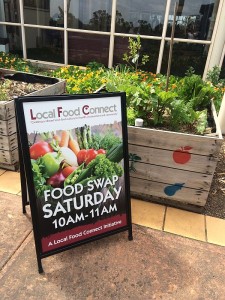How food swaps work
 Food swaps (also known as produce swaps or urban harvests) work by people placing their contributions on a common table. Then they stand around (or sit) chatting. Then, when someone wants to leave, they take whatever they want off the table.
Food swaps (also known as produce swaps or urban harvests) work by people placing their contributions on a common table. Then they stand around (or sit) chatting. Then, when someone wants to leave, they take whatever they want off the table.
No money is involved.
It’s actually a social thing, not a swapping thing.
Often, there is coffee.
Sometimes there are events, like talks.
Click here to read an article on the ABC website about food swaps.
 If you are interested in helping out at your local food swap, email us. Ditto if you are thinking of starting a new food swap in your community.
If you are interested in helping out at your local food swap, email us. Ditto if you are thinking of starting a new food swap in your community.
Some ideas of what you can swap
- Home-grown fruit, veggies, nuts.
- Gardening goodies (coffee grounds, worm juice etc).
- Recycled hessian sacks.
- Something you’ve baked (bread, cake, biscuits – please list ingredients).
- Copies of your favourite seasonal recipe.
- Seeds you’ve saved, seedlings and cuttings you’ve raised (only edible stuff).
- Gardening magazines or gardening books you’ve read.
- Homemade preserves (relishes, jams etc – please list ingredients).
- Re-used little jam jars.
Benefits of food swapping for you
- Add variety to your diet.
- Save money.
- Gain inspiration.
- Meet others you would not normally meet.
- Contribute to sustainability.
- Feel more connected to your community.
- No strings attached – sharing.
Benefits of food swapping for your community
- Strengthen local communities.
- Encourage organics (naturally occurring) spontaneous link within local communities.
- Reduce isolation and provide a connection point for members of the community including elderly and newly arrived residents.
- Foster the growing of food locally, food knowledge and good nutrition.
Benefits of food swapping for your environment
- Cut down food miles.
- Reduces waste, packaging and transport.
- Optimise the use of urban space for sustainability by encouraging backyard food production, making it more viable and rewarding.
- Offering an alternative model of exchange – based on sharing.
- Connect and inform in relation to local food sources, reduction of our footprint on the earth building a resilient ecosystem.

Hi. I have products donated from bakeries and markets. Would I be able to drop them off for others to collect? Thanks.
Hi Alice,
Each food swap is free to have its own rules but my guess would be that most of them would accept your offering.
I’m in the Bendigo area. Is there anything happening here? I love this idea, good old fashioned sharing n caring communities. If there’s nothing happening here, I’d be interested in learning how to make a start please?
Hi Robyn,
I’ve no idea whether or not there are any food swaps around Bendigo. If you want to talk, you can ring me on 0411 520850.
Guy
The old church on the hill may have some info on food swaps. It’s a great community centre, and they have a community garden. It would be a great place to host a food swap or start one. You could also check with Mohammed the facilitator of the Gravel Hill Community Garden in Bendigo. I wrote an article about it a month or two ago.
Hi there, so excited to have found this webpage.
I live in Mont Albert North. Are there any good swaps/gardening workshops in the Whitehorse/Boroondara area?
Hi Carolyn,
A map of all the food swaps in North East Melbourne can be found at https://www.localfoodconnect.org.au/food-swaps/where-they-are. The nearest two to you are Surrey Hills / Balwyn and Box Hill South.
Do you need public liability for the food swap?
Hi Kate,
Yes.
I think that Permaculture Victoria provides public liability for some of the food swaps.
I live in Clayton Vic. I would love to go to a food swap. Can u please tell me of one in the area.
Hi Marie,
There is one in Ashburton (at 38 Winton Road, Ashburton). See https://www.facebook.com/foodforestashburtongroup/
Brilliant video Fay Loveland and Local Food Connect – really explains it well and great visually – gives you really a good sense of the wonderful atmosphere at food swaps.
Sounds wonderful. I would be interested in being a part of one in Benalla or starting one up if there is currently not one there.